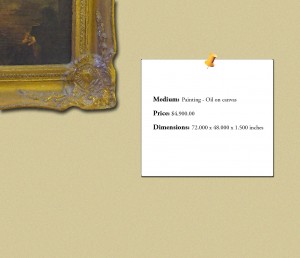by Georgia Lange
 When public workspaces operate as “part-time galleries” by exhibiting artwork on a rotating basis, it can become a controversial public arts issue. Most public workspaces (hospitals, hotels, city halls, banks and offices) typically buy or rent the artwork that is chosen to be put on display. It is often not local or original art, but “decorator” art that is deliberately chosen to fit the design and colors of the interior of the building in question. Because this is typically the case, many artists are fundamentally against the idea of allowing public workspaces to display their work for “exhibitions” without providing advance compensation. It is a rare exception for a public workspace to consistently exhibit artwork on a rotating basis, but it does happen. When it does, the issue of displaying prices on the works being shown becomes more complicated than one might assume.
When public workspaces operate as “part-time galleries” by exhibiting artwork on a rotating basis, it can become a controversial public arts issue. Most public workspaces (hospitals, hotels, city halls, banks and offices) typically buy or rent the artwork that is chosen to be put on display. It is often not local or original art, but “decorator” art that is deliberately chosen to fit the design and colors of the interior of the building in question. Because this is typically the case, many artists are fundamentally against the idea of allowing public workspaces to display their work for “exhibitions” without providing advance compensation. It is a rare exception for a public workspace to consistently exhibit artwork on a rotating basis, but it does happen. When it does, the issue of displaying prices on the works being shown becomes more complicated than one might assume.
Because these public workspaces are not officially considered galleries in the traditional sense, few are aware of the protocol that is usually expected from both the artists and their patrons. Those in charge of running the exhibitions curated for their public work space may find themselves wondering how to display prices for the artwork and how to handle any sales generated from the exhibition. Trying to run an exhibition in a public workspace can be overwhelming for those with no experience or knowledge of how professional curators operate in the same situation. As a result, some of these “public workspace galleries” choose to prohibit prices on the artwork they choose to exhibit, claiming that acting as go-between for the artists and their buyers is “counterproductive” to the interests of the workspace.
For those curating an exhibition for a public workspace that are unfamiliar with how to display prices on the artwork, this article will help clarify how this issue is typically handled in a traditional gallery. There are really two to three ways that I know of to display prices in an art exhibition. The first (and most common) is to print on a clear sticker or a card, with a light adhesive on the back, the artist’s name, the title of the piece, the medium, and the price. This sticker or card is then placed on the wall usually in the lower right-hand corner of the space just below the work of art. The second way I have seen artwork priced (and my personal favorite) is to have a price list in a book that is held at the proctor’s station. Each piece in the exhibition is given a number; that number is placed on the head of a pin. The pin is stuck into the wall in the lower right hand corner below the work of art. The number on the pin corresponds to the numbers in the price list book, to identify each individual piece. A white pin indicates that the piece is still for sale; a red pin indicates that the piece has sold. In my experience, this is the more “high-end” way to establish prices in a gallery setting. A combination method that I have witnessed involves placing the artist’s name and contact information either on the wall next to his or her work and/or in a book held by the gallery proctor. I have never in my life attended an exhibition where prices were not made available at least somewhere in the gallery setting. At the very least, the artist’s contact information will be kept on hand for those who might be interested in buying his or her work.
When prices are prohibited in an art exhibition, the artists tend to avoid getting involved. Artists are in this business to make money from their art. Some claim that its not about making money (and in most cases it shouldn’t be, or we would all starve); its about making a statement, making something that is profound and forces people to think in the artist’s visual terms. But let’s face it; it costs a tremendous amount of both time and money to be creative, and to make back even a tiny fraction of what we’ve spent on creating our art makes the effort feel worthwhile. It is also a great deal of work for the artist to be involved in an exhibition. Getting the work organized, priced properly, framed, transported to the space, contacting all those on their mailing lists to come out and see the show, and taking the time off of a day job to do all this is no easy feat. Artists make the effort to show their work for the fighting chance to sell it. If a public workspace is not willing to help the artists sell their work, it becomes a futile effort for everyone involved. As an artist, I can confidently say that I would not be interested in being involved with an exhibition where pricing is prohibited. If the opportunity to sell my work is squandered by the gallery’s policies, then I feel that the effort is a waste of my time.

Very well stated!
I forwarded your blog to Margaret Travers and Todd Collart of VCCA.